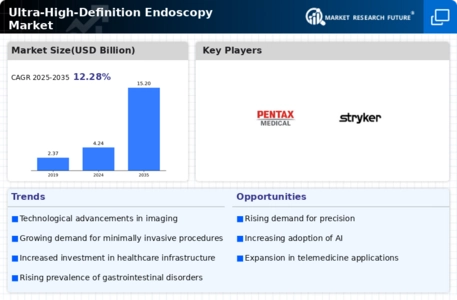Market Analysis
In-depth Analysis of Ultra High Definition Endoscopy Market Industry Landscape
The Ultra High Definition (UHD) endoscopy market is experiencing rapid growth due to technological advancements in medical imaging. UHD endoscopy offers superior image quality, enabling more accurate diagnostics and improved visualization during medical procedures. The technology progression wheel for imaging sensors, optics, and display systems is the major driver in terms of market dynamics. They bring increased resolution, better color accuracy, and sharpened depth of field - one of the factors influencing medical experts to choose UHD endoscopy as a valuable tool. High-definition endoscopy (UDH) offers a new quality that is not available to all the old technologies and which is used by healthcare specialists to make more and more accurate examinations. High rates of disease detection are made possible by enhanced visibility. This facilitates timely diagnosis and treatment, improving patients' chances of recovery and reduces instances of misdiagnosis. This trend of less invasive operation is one key factor that propels the UHD endoscope market to a new height. Surgeons opt for image processing at a sequence of high definition in order to realize the incising and treat very complex cases, which in turn decreases trauma for the patient, and stimulates faster recovery. UHD endoscopy performs a notable role in the progression of a number of medical fields from Gastroenterology, urology, pulmonology to gynecology. The adaptability of the UHD systems makes them capable of operations in the areas of diagnosis, treatment, and therapy and thus, the market of this field is broad. The worldwide healthcare budget is ever expanding leading to more and more money being poured into the clinical research and engineering of cutting edge medical gadgets. Hospitals or healthcare facilities all across the globe are looking at increasing their budgets to adopt UHD endoscopy systems, which is a major driving force in promoting the market growth also. Although these advantages seem real, the high price tag of the UHD global endoscopy system equipment is the major factor that limits its spread in the developing regions. The focus on ways of making these technologies cheaper and more available is crucial for the ability to speed up both the development and the usage of this modern healthcare equipment. UHD endoscopes market is being going on with greater contestation among core manufacturers. M&As follow the market trend as businesses search for products to increase their sales and gain competitive advantage in their local or international markets. On this note, the consumerisation of healthcare highly affects the market concentration.
While developed regions are quick to adopt UHD endoscopy technologies, emerging markets are gradually catching up. The rate of adoption varies regionally, influenced by factors such as healthcare infrastructure, awareness, and economic conditions. The future of the UHD endoscopy market looks promising with ongoing research and development initiatives. Innovations such as artificial intelligence integration, 3D imaging, and the development of compact, portable systems are anticipated to drive the market forward.






Leave a Comment